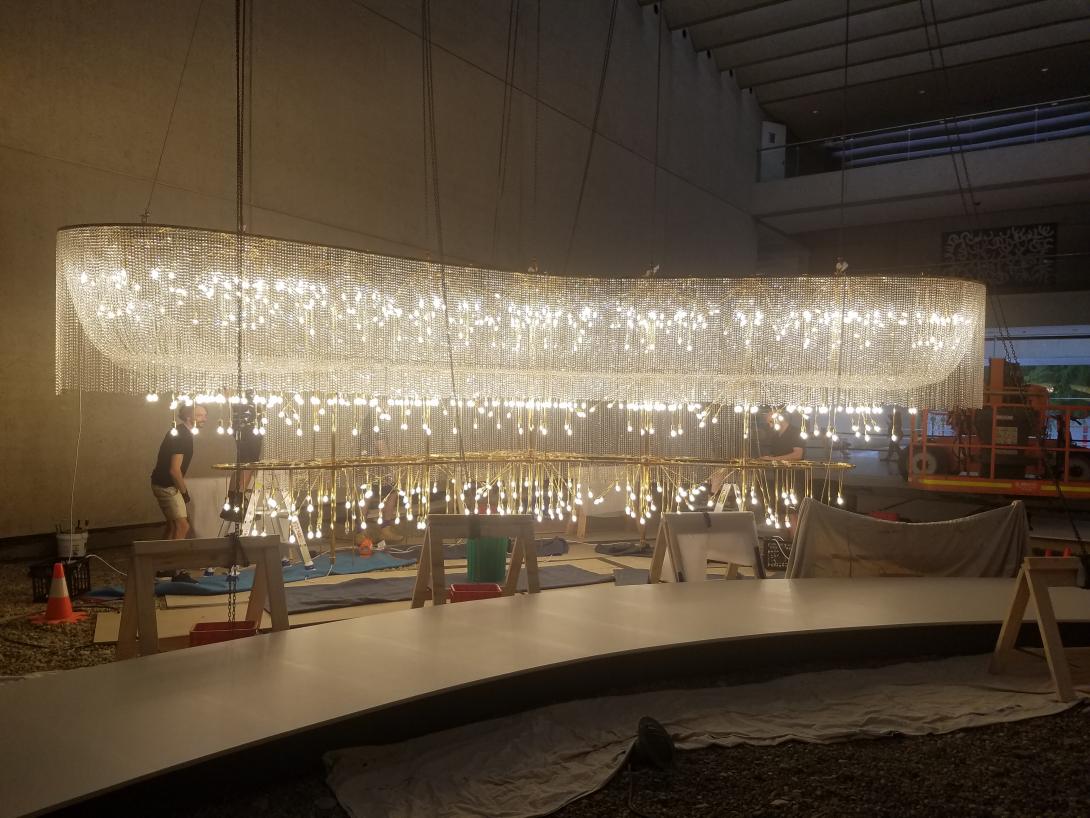A picture of sustainability
By Ari Fuller
Artlines | 4-2021 |
Always aspiring to greener galleries, QAGOMA’s sustainability innovations are a priority across the organisation through waste and energy reduction targets. With a goal of carbon-neutral readiness, writes Ari Fuller, the Gallery’s environmental sustainability policy means your enjoyment of our Collection needn’t cost the earth.
‘What bin do I put this in?’
My colleague and I are standing in one of the Gallery's staff lunchrooms, as I provide advice on a takeaway container’s next destination. Luckily, it’s from QAG Cafe, so straight into the organic bin it goes. All disposables from QAG Cafe and GOMA Bistro — cutlery, coffee cups, containers — have been biodegradable since 2020.
Staff support for QAGOMA’s waste management initiatives has been enormous, but it is easy to get confused with all the new information. We have alternative waste streams to divert materials from landfill, including nitrile gloves, soft plastics, e-waste, organics and polystyrene, but it’s just as important to consider what we purchase as what we dispose. For example, while Artlines is always produced by local printers committed to sustainability, this issue introduces an uncoated cover, making it our first fully recyclable issue.
QAGOMA’s environmental sustainability story has gone from strength to strength over the last five years, culminating in our 2020 commitment to becoming carbon-neutral ready by 30 June 2025. Embarking on this enormous project in an organisation with such varied business operations is daunting, but incredibly exciting. Calculating our emissions requires accounting for vital but carbon‑costly parts of running a gallery: art shipping, exhibition materials, food and beverages, staff travel, waste and, of course, energy usage.
The reduction of electricity usage — our greatest single source of carbon emissions — is at the top of our sustainability list. We have implemented processes to save electricity wherever possible in our operations, from computers to lighting to air-conditioning. Energy reduction, along with an accelerated shift to renewable energy sources, is also high on the agenda of Arts Queensland, which manages the Cultural Precinct. Arts Queensland has been instrumental in funding upgrades to our air-conditioning and plant equipment, as well as transitioning to LED lights in the galleries and staff areas. As the weather heats up, these upgrades are resulting in significant cost savings and emissions reductions.

Ai Weiwei’s Boomerang 2006 undergoing rewiring for energy-efficient LED bulbs, 2020 / Photograph: QAGOMA
Living in the warmth of this stunning subtropical city brings unique challenges for conserving the state’s art collection. Temperature and humidity need to be carefully controlled, and this requires lots of energy. However, QAGOMA’s Conservation team has recently led an Australian agreement to broaden those temperature and humidity requirements for domestic lending of artworks; this means we can reduce energy usage while still maintaining works in optimal conditions.
As an example, the much-loved Collection highlight Boomerang 2006 — Ai Weiwei’s oversized chandelier currently installed in the Watermall [2021] — was completely rewired in 2020 and refitted with LED bulbs. This artwork, created as a parody of ostentatious displays of wealth, now takes on a further layer of meaning: its energy‑saving upgrades now contrast with its excessive appearance.
The works exhibited at QAGOMA can be thought-provoking, emotive, fun and meaningful. Now you can be assured that, whatever the show and whatever your reaction to it, we are making it happen with the best interests of the environment in mind. And soon enough, we hope to support your visit at zero cost to the climate, so you can breathe easy in the cool of our galleries.
Ari Fuller is Facilities Management Officer. Find out more about QAGOMA’s Sustainability Policy at www.qagoma.qld.gov.au/sustainability.

Boomerang 2006
- AI Weiwei - Creator
